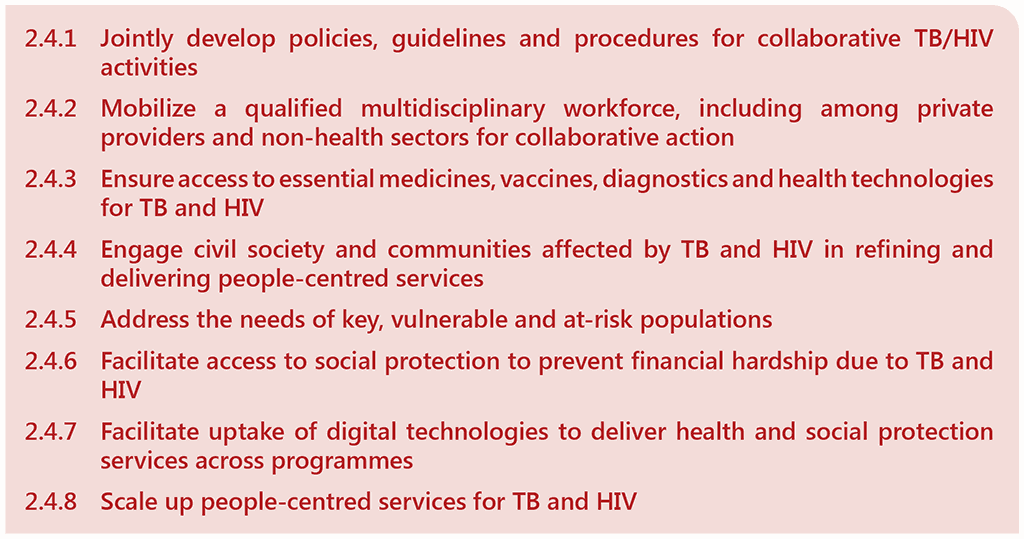2.4 Implement and scale up people-centred services for HIV-associated TB

2.4.1 Jointly develop policies, guidelines and procedures for collaborative TB/HIV activities
 TB KaSPar
TB KaSPar
 Feedback
Feedback

2.4.1 Jointly develop policies, guidelines and procedures for collaborative TB/HIV activities

2.3.1 Identify priority comorbidities and interventions

2.2.1 Assess the joint burden of TB and HIV

2.1.1 Strengthen political commitment, coordination and accountability for collaborative action on TB and HIV
Table 1.1 summarizes all existing WHO recommendations2 that relate to HIV-associated TB in adults, as published in the WHO consolidated guidelines on tuberculosis. Module 6: tuberculosis and comorbidities. HIV-associated TB (in press). Some recommendations will however also be relevant for children and adolescents. A full summary of recommendations on HIV-associated TB for children and adolescents specifically, can be found in the WHO consolidated guidelines on tuberculosis. Module 5: management of TB in children and adolescents (8).
The development of the section on HIV-associated TB (hereinafter referred to as the TB/HIV section) was coordinated by the WHO Global Tuberculosis Programme in collaboration with the Department of Global HIV, Hepatitis and Sexually Transmitted Infections Programmes. A WHO steering group was set up in 2022 to guide the development of the TB/HIV section, and a stakeholder consultation with a broad array of experts was convened in September 2022, to inform the drafting process.
People with HIV are 12–16 times more likely to develop tuberculosis (TB) disease. They also have poorer TB treatment outcomes and have more than two-fold higher mortality during TB treatment compared to people without HIV (1). Despite advances in the prevention, diagnosis and treatment of TB disease, TB remains the leading cause of death among people with HIV worldwide, accounting for 167 000 (27%) of global AIDS-related deaths in 2022 (1).
Close to half of people estimated to have HIV-associated TB are not diagnosed and reported (1). Post-mortem studies have found very high prevalence of undiagnosed TB among people with HIV who have died in healthcare facilities in high TB burden settings (2). Early identification of signs and symptoms of TB followed by diagnosis and prompt initiation of treatment in people living with HIV reduces mortality, improves health-related quality of life and reduces transmission of TB.
To support countries in the introduction and scale-up of collaborative action on TB and comorbidities, including for HIV-associated TB, WHO developed the Framework for collaborative action on tuberculosis and comorbidities (22).